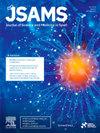Survival and longevity among male Australian elite athletes: A retrospective cohort study
IF 3
2区 医学
Q1 SPORT SCIENCES
引用次数: 0
Abstract
Objectives
To quantify and compare survival and longevity in three populations of male Australian elite athletes, relative to sex- and age-matched referents from the general population.
Design
Retrospective cohort study.
Methods
This study comprised a census of three populations of male Australian elite athletes (i.e. N = 10,502 Australian Football League players, N = 803 national team rugby union players, and N = 1527 Olympic athletes) who debuted from 1-JAN-1921 to 31-DEC-2023. Nonparametric relative survival analysis was conducted using the Kaplan–Meier estimator to generate survival curves, the Pohar Perme method and a log-rank type test to estimate and compare net survival, and the life years difference measure to estimate longevity gains or losses.
Results
Olympic athletes had a continuous gain in net survival post-debut, with an average life years difference of 3.40 (95 % confidence interval 2.30 to 4.49) years at the maximum follow-up time. Australian football and rugby union players initially had modest gains in net survival post-debut, followed by a gradual decline in net survival, with average life years differences of 0.31 (95 % confidence interval −0.03 to 0.65) and −0.67 (95 % confidence interval −1.87 to 0.53) years at the maximum follow-up time, respectively. Net survival was significantly different across the three cohorts (test statistic 21.8; degrees of freedom = 2; p < 0.001).
Conclusions
Expected survival benefits were offset in elite male Australian football and rugby union players. Further research examining cause-specific mortality is warranted to elucidate the underlying reasons for the observed lack of expected survival benefit in Australian football and rugby union players.
澳大利亚男性精英运动员的存活率和寿命:回顾性队列研究
目标:量化并比较澳大利亚三个男性精英运动员群体的存活率和寿命:量化并比较三个澳大利亚男性精英运动员群体与性别和年龄匹配的普通人群参照者的存活率和寿命:设计:回顾性队列研究:本研究对 1921 年 1 月 1 日至 2023 年 12 月 31 日期间出道的三个澳大利亚男性精英运动员群体(即 N = 10,502 名澳大利亚足球联赛运动员、N = 803 名国家队橄榄球联盟运动员和 N = 1527 名奥运会运动员)进行了普查。使用卡普兰-梅耶估计器生成生存曲线,使用波哈尔-佩尔梅法和对数秩类型检验估算和比较净生存率,并使用生命年数差异测量法估算长寿增减,从而进行了非参数相对生存分析:结果:奥林匹克运动员在退役后的净存活率持续上升,在最长随访时间内,平均寿命差异为 3.40 岁(95 % 置信区间为 2.30 至 4.49 岁)。澳式足球和橄榄球联盟运动员在退役后的净存活率最初略有提高,随后净存活率逐渐下降,在最长随访时间内的平均寿命年数差异分别为 0.31(95 % 置信区间-0.03 至 0.65)年和-0.67(95 % 置信区间-1.87 至 0.53)年。三个组群的净存活率存在明显差异(检验统计量 21.8;自由度 = 2;P 结论:在精英男子中,预期的存活率优势被抵消了:澳式足球和橄榄球联盟精英男子运动员的预期生存率被抵消。有必要对特定病因死亡率进行进一步研究,以阐明澳式足球和橄榄球联盟运动员缺乏预期生存益处的根本原因。
本文章由计算机程序翻译,如有差异,请以英文原文为准。
求助全文
约1分钟内获得全文
求助全文
来源期刊
CiteScore
7.40
自引率
10.00%
发文量
198
审稿时长
48 days
期刊介绍:
The Journal of Science and Medicine in Sport is the official journal of Sports Medicine Australia (SMA) and is an an international refereed research publication covering all aspects of sport science and medicine.
The Journal considers for publication Original research and Review papers in the sub-disciplines relating generally to the broad sports medicine and sports science fields: sports medicine, sports injury (including injury epidemiology and injury prevention), physiotherapy, podiatry, physical activity and health, sports science, biomechanics, exercise physiology, motor control and learning, sport and exercise psychology, sports nutrition, public health (as relevant to sport and exercise), and rehabilitation and injury management. Manuscripts with an interdisciplinary perspective with specific applications to sport and exercise and its interaction with health will also be considered.

 求助内容:
求助内容: 应助结果提醒方式:
应助结果提醒方式:


